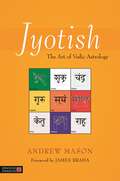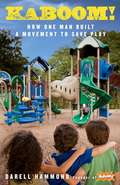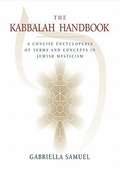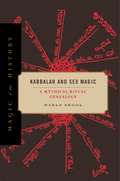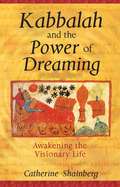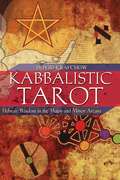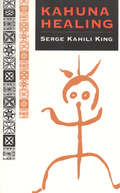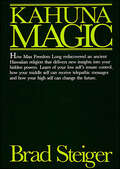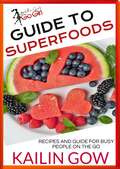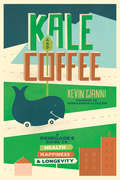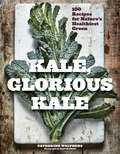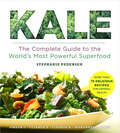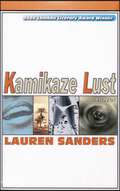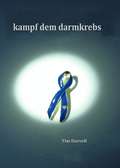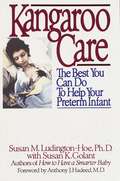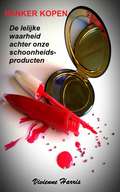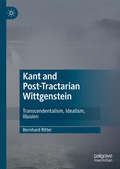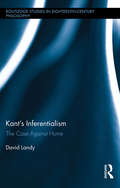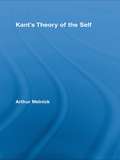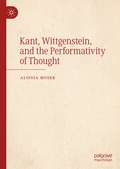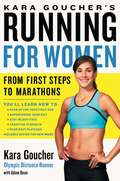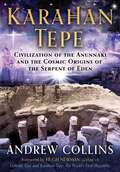- Table View
- List View
Jyotish: The Art of Vedic Astrology
by Andrew Mason James BrahaAn authoritative primer to Jyotish, or Vedic Astrology, this book draws on the author's extensive study of the tradition. Andrew Mason explains in detail the practical applications of Jyotish, introduces the planets, signs and houses, as well as the many rich and highly entertaining mythologies of the system with an explanation of how to interpret them. He also covers Vedic Astrology's sister science, Ayurveda, and describes how they interact to provide insight into celestial timing, sustained health and general wellbeing. With sample charts that show the applications throughout, the book provides a complete an accessible resource on Jyotish for students of Indian astrology and Ayurveda practitioners. It will also be of interest to anyone with a passion for astrology.
KaBOOM! How One Man Built a Movement to Save Play
by Stuart Brown Darell HammondKaBOOM! chronicles Darell Hammond's amazing journey from a childhood spent living in a group home in Illinois to becoming the cofounder and CEO of KaBOOM!, an organization with this mission at its core: harnessing the power of community to save play for children... one playground at a time. Like The Blue Sweater and Three Cups of Tea, KaBOOM! demonstrates how one idealist can change the world and how small, civic-minded steps create a ripple effect that can precipitate change in communities and eventually change in the world at large. More than just a memoir, KaBOOM! is a call to action that will inspire readers by challenging them to rethink traditional notions of community and social change. This is the story of a man with a vision: Play is the best natural resource in a creative economy. Kids need more of it-it is not a luxury but a necessity for their lives. Through hard work, commitment, and the conviction that access to a safe play environment is the fundamental right of all children, Hammond built an organization that has raised almost $200 million, directly built 2,000 playgrounds with a million volunteers, and touched the lives of countless children and families. Photo captions are included after the index, starting on p. 287.
Kabbalah Handbook
by Gabriella SamuelA comprehensive single-volume reference guide to the terms and ideas of Kabbalah by a longtime teacher of Jewish mysticism -perfect for the serious student and newcomer alike. People of all faiths and backgrounds are drawn to the inspiration, knowledge, and spiritual insight that Kabbalah offers. But too often writings on Jewish mysticism are impenetrable for the novice, overly simplified for the advanced student, or misrepresent and sensationalize Kabbalistic practice. The Kabbalah Handbook is the first comprehensive single-volume Kabbalah reference guide that is indispensable for Kabbalah students of every level. The Kabbalah Handbook features: - more than five hundred key terms and concepts in straightforward, easy-to-read definitions and thorough, well-researched discussions; - Hebrew, English, and Hebrew transliteration for each item; - the language of origin for each term; - a discussion of all sides of differing opinions within Kabbalistic philosophy; - pronunciation guides; - nondiscriminatory, gender-neutral language; - important historical information; - extensive cross-referencing that enables readers to find all terms, whether they are looking up a word in English or transliterated Hebrew; - twenty-eight original and innovative illustrations; - thirty-two tables and charts that organize and break down unwieldy material into manageable items; and - appendices covering topics such as the 613 Mitzvot (biblical commandments), the lunar calendar, and the sacred names of God.
Kabbalah and Sex Magic: A Mythical-Ritual Genealogy (Magic in History #23)
by Marla SegolIn this provocative book, Marla Segol explores the development of the kabbalistic cosmology underlying Western sex magic. Drawing extensively on Jewish myth and ritual, Segol tells the powerful story of the relationship between the divine and the human body in late antique Jewish esotericism, in medieval kabbalah, and in New Age ritual practice.Kabbalah and Sex Magic traces the evolution of a Hebrew microcosm that models the powerful interaction of human and divine bodies at the heart of both kabbalah and some forms of Western sex magic. Focusing on Jewish esoteric and medical sources from the fifth to the twelfth century from Byzantium, Persia, Iberia, and southern France, Segol argues that in its fully developed medieval form, kabbalah operated by ritualizing a mythos of divine creation by means of sexual reproduction. She situates in cultural and historical context the emergence of Jewish cosmological models for conceptualizing both human and divine bodies and the interactions between them, arguing that all these sources position the body and its senses as the locus of culture and the means of reproducing it. Segol explores the rituals acting on these models, attending especially to their inherent erotic power, and ties these to contemporary Western sex magic, showing that such rituals have a continuing life. Asking questions about its cosmology, myths, and rituals, Segol poses even larger questions about the history of kabbalah, the changing conceptions of the human relation to the divine, and even the nature of religious innovation itself. This groundbreaking book will appeal to students and scholars of Jewish studies, religion, sexuality, and magic.
Kabbalah and Sex Magic: A Mythical-Ritual Genealogy (Magic in History)
by Marla SegolIn this provocative book, Marla Segol explores the development of the kabbalistic cosmology underlying Western sex magic. Drawing extensively on Jewish myth and ritual, Segol tells the powerful story of the relationship between the divine and the human body in late antique Jewish esotericism, in medieval kabbalah, and in New Age ritual practice.Kabbalah and Sex Magic traces the evolution of a Hebrew microcosm that models the powerful interaction of human and divine bodies at the heart of both kabbalah and some forms of Western sex magic. Focusing on Jewish esoteric and medical sources from the fifth to the twelfth century from Byzantium, Persia, Iberia, and southern France, Segol argues that in its fully developed medieval form, kabbalah operated by ritualizing a mythos of divine creation by means of sexual reproduction. She situates in cultural and historical context the emergence of Jewish cosmological models for conceptualizing both human and divine bodies and the interactions between them, arguing that all these sources position the body and its senses as the locus of culture and the means of reproducing it. Segol explores the rituals acting on these models, attending especially to their inherent erotic power, and ties these to contemporary Western sex magic, showing that such rituals have a continuing life. Asking questions about its cosmology, myths, and rituals, Segol poses even larger questions about the history of kabbalah, the changing conceptions of the human relation to the divine, and even the nature of religious innovation itself. This groundbreaking book will appeal to students and scholars of Jewish studies, religion, sexuality, and magic.
Kabbalah and the Power of Dreaming: Awakening the Visionary Life
by Catherine ShainbergA dynamic exposition of the powerful, ancient Sephardic tradition of dreaming passed down from the renowned 13th-century kabbalist Isaac the Blind• Includes exercises and practices to access the dream state at will in order to engage with life in a state of enhanced awareness • Written by the close student of revered kabbalist Colette Aboulker-Muscat In Kabbalah and the Power of Dreaming Catherine Shainberg unveils the esoteric practices that allow us to unlock the dreaming mind's transformative and intuitive powers. These are the practices used by ancient prophets, seers, and sages to control dreams and visions. Shainberg draws upon the ancient Sephardic Kabbalah tradition, as well as illustrative stories and myths from around the Mediterranean, to teach readers how to harness the intuitive power of their dreaming. While the Hebrew Bible and our Western esoteric tradition give us ample evidence of dream teachings, rarely has the path to becoming a conscious dreamer been articulated. Shainberg shows that dreaming is not something that merely takes place while sleeping--we are dreaming at every moment. By teaching the conscious mind to be awake in our sleeping dreams and the dreaming mind to be manifest in daytime awareness, we are able to achieve revolutionary consciousness. Her inner-vision exercises initiate creative and transformative images that generate the pathways to self-realization.
Kabbalistic Tarot: Hebraic Wisdom in the Major and Minor Arcana
by Dovid KrafchowAn introduction to the ancient kabbalistic origins and meanings of the tarot • Reveals the intimate relationship of the tarot to the esoteric teachings of the Torah and the Kabbalah• Provides kabbalistic interpretations for all 78 traditional tarot cards• Includes a detailed kabbalistic reading and interpretation of the Tree of Life spreadWhen the Greeks invaded Israel and forbade study of the Torah, the Jewish people began a secret method of Toranic study that appeared to be merely a simple way to fill time: playing cards. These first tarot decks enabled study of the Torah without detection. Once the Maccabees expelled the Greeks from Israel and Israel once again became a Jewish kingdom, tarot cards dropped from sight. Fifteen hundred years later, in response to Jewish disputations with Catholic theologians, political and religious persecutions, and ultimately the Inquisition, the cards resurfaced as a secret learning tool of the Torah.In Kabbalistic Tarot, Dovid Krafchow details how the true meaning of the tarot is locked within the Kabbalah. He shows the correspondence between the 22 Major Arcana cards and the 22 letters of the Hebrew alphabet and how the four suits correspond to the four kabbalistic worlds of Briah, Yitzerah, Asiyah, and Atzilut. He describes the kabbalistic meanings of each of the 78 cards and their relations to the Torah and provides insight into the Tree of Life spread through several kabbalistic readings.
Kahuna Healing
by Serge Kahili KingThe author sets forth the ancient Hawaiian tradition which includes a complete program for the prevention and cure of illness---a holistic health program involving the physical, emotional, mental, and spiritual aspects of human beings.
Kahuna Healing
by Serge Kahili KingThe author sets forth the ancient Hawaiian tradition which includes a complete program for the prevention and cure of illness---a holistic health program involving the physical, emotional, mental, and spiritual aspects of human beings.
Kahuna Magic
by Brad SteigerTrain yourself to interpret dreams, heal the sick or travel out of body. These occult feats defy the logic of our modern world, yet they can be a potent force in your life. The author, a well-known authority on psychic and occult experiences, shows how a knowledge of "Huna," an ancient Hawaiian religion, helps you master feats of occult magic. With this unique guidebook, you can teach yourself the ancient Kahuna techniques. Use them to foresee the future, to increase your wealth, to control the weather and other ways to enrich your life. As the author says, "I want readers to discover their ability to apply some of the psychic secrets employed by the Kahunas."
Kailin Gow's Go Girl Guide to Superfoods: Recipes For Busy People On The Go! (Kailin Gow's Go Girl Guides Series #1)
by Kailin GowBased on the hit TV Series about food, travel, and lost history, hosted by Kailin Gow, comes this guide to Superfoods and recipes that any busy on-the-go person can make to create a healthier, energized, and good-for-you delicious meal.* Find out the Top Natural Superfoods Good for Preventing Cancer* Find out the Top Natural Superfoods Good for Diabetes Prevention* Find out the Top Natural Superfoods Good for Joints and Pain Relief* What are the Top Natural Superfoods to Build Bones* What are the Top Natural Superfoods to Build Blood Cells* What are the Top Natural Superfoods to Help You Live Longer. Includes Recipes for Delicious Meals using Superfoods so you can incorporate a healthy lifestyle as part of your daily life.
Kaiser Permanente Healthwise Handbook
by Donald W. KemperA self-care guide for you and your family, this handbook is a reliable, up-to-date, and easy-to-understand source of help for over 200 medical problems.
Kale and Coffee: A Renegade's Guide To Health, Happiness, And Longevity
by Kevin GianniInternet celebrity Kevin Gianni was intent on finding the keys to perfect wellness and sharing them with the 10 million viewers of his YouTube show, Renegade Health. So he and his wife bought a 36-foot, bio-fueled RV – dubbed "the Kale Whale" – and spent two and a half years crisscrossing the continent, talking to experts and ordinary folks about what works and what doesn’t when it comes to a healthy life. Gianni drank wheatgrass shots, gave up sugar, said goodbye to coffee, and used himself as a guinea pig to uncover the truths and myths behind every nutrition plan said to guarantee good health. As he cycled through "healthy" diets – vegetarian, vegan, raw foods, and more – he got sicker and sicker. Finally, he hit bottom and had to give up healthy eating to save his life.Kale and Coffee is the often hilarious, picaresque tale of how Gianni went from skinny, raw-food vegan faddist to bloated, out of shape omnivore before finding the middle way to an imperfectly healthy and (more) balanced life. The journey takes him from the Peruvian Andes to salt flats in Mexico to a pig farm and butcher shop near his northern California home. Along the way, he has his brain scanned and his pantry tested for toxic metals, does an all-water fast, runs the grueling Tough Mudder endurance race, and obsesses on the secrets of the world’s longest-lived people.With the humor and practical wisdom that have delighted millions, Gianni shows you how to sidestep the health hype, diet fads, and weight-loss promises littering the path to wellness. Drawing on his own experience and the advice of trusted experts, he guides you in finding your own personal plan for optimal nutrition and fitness.Includes the Kale and Coffee 21-Day Jumpstart
Kale, Glorious Kale: 100 Recipes for Nature's Healthiest Green (New format and design)
by Alison Shaw Catherine Walthers100 accessible recipes that will appeal to even the pickiest eater. Kale is a superstar among superfoods. It is packed with vitamins, antioxidants, and anti-inflammatories; supports the cardiovascular and digestive systems; promotes healthy eyes and bones; and plays an important role in the body’s detoxification processes. But not everyone has been quick to jump on the kale train. In Kale, Glorious Kale, Catherine Walthers shares recipes that explore all of the possibilities of this versatile vegetable. In addition to numerous fresh and flavorful salads, recipes include: Baked Eggs Over Kale Kale and Feta Pizza Penne with Kale, Sausage, and Mushrooms Cider-Braised Kale and Chicken For kale lovers as well as neophytes.
Kale: The Complete Guide to the World's Most Powerful Superfood (Superfoods for Life)
by Stephanie PedersenKale is the veggie everyones gone mad for—from farmers and foodies to celebrity chefs! For those eager to get in on this healthy, tasty trend, here is a fun-to-read, one-stop resource for all things kale, including more than 75 recipes to entice, satisfy, and boost your well-being. The dishes include meltingly tender stews, flash-sautéed side dishes, salads and slaws, sandwiches, smoothies, and even muffins and chips. Stephanie Pedersen, a holistic health counselor and experienced health writer, provides dozens of tips for making kale delicious and desirable to even the most finicky eater. Youll even learn how to start your own kale garden and turn over a new leaf for a healthier life.
Kamikaze Lust
by Lauren SandersKamikaze Lust puts a crackling, rapid-fire spin on a traditional theme--young woman in search of herself--and stands it on its head. Kamikaze Lust by first-time novelist Lauren Sanders takes the reader on an electrifying ride through the spectacle of life and death in millennial America. Smart, hardboiled and humorous, the novel taps our obsession with sex and death, sex and popular culture, sex and the written word, sex and pornography, sex and green M&Ms, and, of course, the perennial sex and love. "Great courage must account for such complete disregard of political correctness, and great sensitivity for such sadness." —Amanda Filipacchi, author of Vapor and Nude Men
Kampf dem Darmkrebs
by Tim Darvell Christina BergmannSeit April 2012 ist das so gefürchtete Wort „Krebs“ Teil unserer Familie. Gerade saß ich noch neben meiner Mutter und erwartete eine normale Entlassung aus dem Krankenhaus. Und innerhalb eines Sekundenbruchteils wurde meine Welt auf den Kopf gestellt, als uns gesagt wurde, dass meine Mum Darmkrebs hatte. Dieses Buch enthält Fotos mit verschiedenen Motiven, Ideen und Techniken. Mit diesem Buch, seinen Bildern und den Geschichten dazu sammle ich Spenden für die Stiftung „Beating Bowel Cancer“, zu Deutsch Kampf dem Darmkrebs. Alle Erträge werden der Stiftung gespendet.
Kangaroo Care: The Best You Can Do to Help Your Preterm Infant
by Susan Ludington-HoeFrom an internationally-known expert in child health, here is a dramatically new approach to caring for premature babies--and a wonderful new role for parents. Filled with information about the special needs of fragile newborns and illustrated with step-by-step photos.
Kanker kopen - De lelijke waarheid achter onze schoonheidsproducten
by Vivienne Harris L. N.Als consumenten hebben we het recht te weten waar onze producten vandaan komen, hoe ze worden gemaakt en of het voordeel van het bezitten van dat product groter is of niet. En omdat we producten kopen met ons zuurverdiende geld, hebben we het recht om de best mogelijke kwaliteit te krijgen. Bedrijven hebben echter geen morele verplichtingen jegens consumenten en dit is een feit dat ze gemakkelijk kunnen uitbuiten. De cosmetische industrie is niet anders, en in dit boek leer je uit de eerste hand hoe bedreigend de chemicaliën die ze gebruiken in onze producten zijn. Je leert hoe je de shampoo & conditioner gebruikt, de lipgloss die je niet zonder kunt, de lotion die je op je lichaam aanbrengt om je huid te hydrateren tot de tandpasta die je dagelijks gebruikt, allemaal vervuild zijn met giftige ingrediënten die oorspronkelijk ontworpen om alleen industriële apparatuur schoon te maken of om uw versnellingsbak te smeren. De gezondheidsimpact van deze ingrediënten die zo mooi zijn verpakt, is echt verschrikkelijk. De mascara, deodorant, gezichtsmasker, nagellak, lippenbalsem, concealer en douchegel die u gebruikt, bevatten meestal chemicaliën die in verband zijn gebracht met kanker en geboorteafwijkingen en die zijn geclassificeerd als schadelijk voor het vrouwelijke voortplantingsstelsel. Dus als consumenten moeten we onszelf onderwijzen om onze gezondheid en welzijn te beschermen. Het is niet genoeg voor deze miljardenindustrie om ons geld te nemen, ze willen ook dat de meesten van ons ziek worden, en waar mogelijk de rest doden. Vrouwen zijn krachtige consumenten en als ze de dodelijke (maar subtiele) wapens herkennen die deze industrie tegen hen gebruikt, zullen ze in staat zijn a) hun gezondheid te beschermen en b) gezonde en gereguleerde producten te eisen. Dit boek zal je de geheimen tonen die deze industrie veel geld verbergt om te verbergen, en de diepte van dit ernstige en dringende probleem.
Kant and Post-Tractarian Wittgenstein: Transcendentalism, Idealism, Illusion
by Bernhard RitterThis book suggests that to know how Wittgenstein’s post-Tractarian philosophy could have developed from the work of Kant is to know how they relate to each other. The development from the latter to the former is invoked heuristically as a means of interpretation, rather than a historical process or direct influence of Kant on Wittgenstein. Ritter provides a detailed treatment of transcendentalism, idealism, and the concept of illusion in Kant’s and Wittgenstein’s criticism of metaphysics. Notably, it is through the conceptions of transcendentalism and idealism that Wittgenstein’s philosophy can be viewed as a transformation of Kantianism. This transformation involves a deflationary conception of transcendental idealism along with the abandonment of both the idea that there can be a priori 'conditions of possibility' logically detachable from what they condition, and the appeal to an original ‘constitution’ of experience. The closeness of Kant and post-Tractarian Wittgenstein does not exist between their arguments or the views they upheld, but rather in their affiliation against forms of transcendental realism and empirical idealism. Ritter skilfully challenges several dominant views on the relationship of Kant and Wittgenstein, especially concerning the cogency of Wittgenstein-inspired criticism focusing on the role of language in the first Critique, and Kant's alleged commitment to a representationalist conception of empirical intuition.
Kant's Inferentialism: The Case Against Hume (Routledge Studies in Eighteenth-Century Philosophy)
by David LandyKant’s Inferentialism draws on a wide range of sources to present a reading of Kant’s theory of mental representation as a direct response to the challenges issued by Hume in A Treatise of Human Nature. Kant rejects the conclusions that Hume draws on the grounds that these are predicated on Hume’s theory of mental representation, which Kant refutes by presenting objections to Hume’s treatment of representations of complex states of affairs and the nature of judgment. In its place, Kant combines an account of concepts as rules of inference with a detailed account of perception and of the self as the locus of conceptual norms to form a complete theory of human experience as an essentially rule-governed enterprise aimed at producing a representation of the world as a system of objects necessarily connected to one another via causal laws. This interpretation of the historical dialectic enriches our understanding of both Hume and Kant and brings to bear Kant’s insights into mental representation on contemporary debates in philosophy of mind. Kant’s version of inferentialism is both resistant to objections to contemporary accounts that cast these as forms of linguistic idealism, and serves as a remedy to misplaced Humean scientism about representation.
Kant's Theory of the Self (Routledge Studies in Eighteenth-Century Philosophy)
by Arthur MelnickThe self for Kant is something real, and yet is neither appearance nor thing in itself, but rather has some third status. Appearances for Kant arise in space and time where these are respectively forms of outer and inner attending (intuition). Melnick explains the "third status" by identifying the self with intellectual action that does not arise in the progression of attending (and so is not appearance), but accompanies and unifies inner attending. As so accompanying, it progresses with that attending and is therefore temporal--not a thing in itself. According to Melnick, the distinction between the self or the subject and its thoughts is a distinction wholly within intellectual action; only such a non-entitative view of the self is consistent with Kant’s transcendental idealism. As Melnick demonstrates in this volume, this conception of the self clarifies all of Kant’s main discussions of this issue in the Transcendental Deduction and the Paralogisms of Pure Reason.
Kant, Wittgenstein, and the Performativity of Thought
by Aloisia MoserThis book explores the idea that there is a certain performativity of thought connecting Kant’s Critique of Pure Reason and Wittgenstein’s Tractatus Logico-Philosophicus. On this view, we make judgments and use propositions because we presuppose that our thinking is about something, and that our propositions have sense. Kant’s requirement of an a priori connection between intuitions and concepts is akin to Wittgenstein’s idea of the general propositional form as sharing a form with the world. Aloisia Moser argues that Kant speaks about acts of the mind, not about static categories. Furthermore, she elucidates the Tractatus’ logical form as a projection method that turns into a so-called ‘zero method’, whereby propositions are merely the scaffolding of the world. In so doing, Moser connects Kantian reflective judgment to Wittgensteinian rule-following. She thereby presents an account of performativity centering neither on theories nor methods, but on the application enacting them in the first place.
Kara Goucher's Running for Women: From First Steps to Marathons
by Kara GoucherGET FIT, GET FAST, AND GO FARTHER WITH OLYMPIC RUNNER KARA GOUCHER’S COMPREHENSIVE GUIDE TO RUNNING FOR WOMEN KARA GOUCHER is crazy, madly, head-over-heels in love with running, and she wants to help you feel that love, too. Whether you’re just getting started or already a seasoned runner, this is the book that will take you to the next level. Kara Goucher’s Running for Women contains her expertise, tips, and tricks targeted specifically at female runners to help you become a better, happier, healthier, and more fulfilled runner. She’ll teach you how to: • GET STARTED WITH THE RIGHT GEAR • BUILD A SUCCESSFUL SUPPORT TEAM • FIND THE RIGHT TRAINING PROGRAM FOR YOU • OVERCOME PSYCHOLOGICAL SETBACKS • BALANCE RUNNING WITH FAMILY AND WORK • AND MUCH MORE Designed to fit your busy lifestyle, Kara Goucher’s Running for Women is packed with quick tips, pearls of running wisdom, and sample training schedules and nutrition plans, as well as sections dedicated to running during and after pregnancy, managing the special challenges of the female athlete’s body, and maintaining a balance between sporting and family life. Kara Goucher’s Running for Women is the ultimate guide for women who want to train for the gold or simply discover their personal best.
Karahan Tepe: Civilization of the Anunnaki and the Cosmic Origins of the Serpent of Eden
by Andrew Collins• Examines the intricate carvings, chambers, and structures, revealing the site&’s acoustical properties, shamanic symbolism, and astronomical alignments• Reveals how Karahan Tepe was used by shamans to connect with the Milky Way&’s Galactic bulge in its role as the head of the cosmic serpent• Explains how the site&’s builders, who created the world&’s first post ice age civilization, are remembered in myth and legend as the Watchers and Nephilim of Jewish religious tradition and as the Anunnaki gods of Sumerian mythologyConsidered the most important archaeological discovery of the 21st century, Karahan Tepe is an enormous complex of stone structures in southeastern Turkey covering an estimated ten acres. Built more than 11,000 years ago, Karahan Tepe contains some of the oldest monumental architecture anywhere on Earth, including human and animal statues, ubiquitous snake carvings, T-shaped pillars, and interconnecting underground enclosures with stone columns carved directly from the bedrock.Chronicling his explorations of Karahan Tepe, Andrew Collins presents the first in-depth investigation of the discoveries at the site: who built it, its astronomical alignments, and its cosmological connections. He examines the intricate carvings and architectural features, including a newly discovered statue of a giant human figure. Explaining how the site functioned as a shamanic oracle center, Collins shows how its rock-cut structures were used to connect with the Milky Way&’s Galactic Bulge and stars of Scorpius in their role as the head and active spirit of a perceived cosmic serpent. He traces this serpent motif throughout history, identifying it with the biblical serpent of Eden, the kundalini of Vedic tradition, and the black snake of the Yezidis. He demonstrates how the belief in the existence of the Milky Way serpent among the inhabitants of Karahan Tepe went on to influence the foundation of the Gnostic Ophite mysteries suppressed by the Christian Church. He also shows how the founders of Karahan Tepe were recalled in Hebrew myth and legend as the Watchers and Nephilim and in Sumerian and Babylonian mythology as the Anunnaki.Sharing a wealth of evidence, Collins confirms that Karahan Tepe and its sister site of Göbekli Tepe belonged to the world&’s first post–Ice Age civilization, which today bears the enigmatic name of Taş Tepeler.
